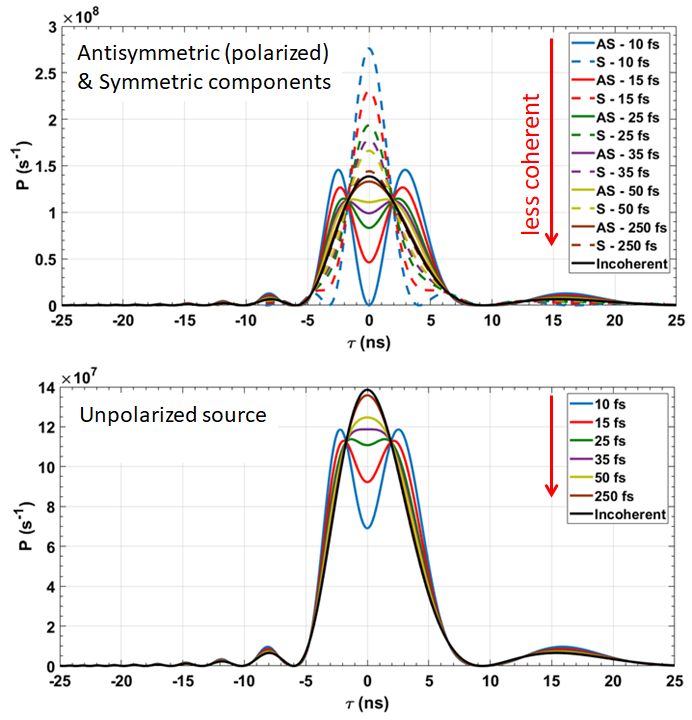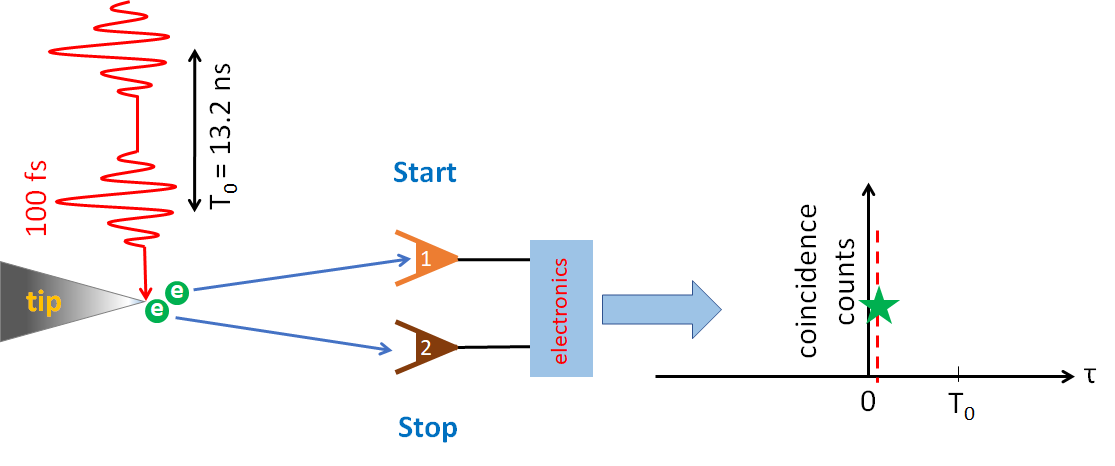Projects
Hanbury-Brown Twiss Experiment for Spin-Polarized Fermions
|
Free electron anti-bunching attributed to the Pauli force using a high-brightness field-emission source was first reported in 2002 [1]. Ultrashort pulsed nanotip sources of electrons have been widely studied since then due to their applications in time-resolved electron diffraction and microscopy [2]. In a theoretical work from Prof. Batelaan’s group at UNL [3], it was recently shown that a partial quantum coherence in such ultrashort beams is anticipated to lead to a much stronger anti-bunching signal than in the CW beam of Ref. [1]. In addition, it was also shown in Ref. [3] that for partially polarized electron beams the sought-after signal is more pronounced due to a higher probability for spin-parallel wavepackets to overlap. Moreover, given that it is possible to optically switch between polarized and unpolarized beams using GaAs nanotips (see William Newman’s explanation of the Mott polarimeter) this is expected to provide a means to unambiguously distinguish between anti-bunching due to Pauli force and Coulomb repulsion for the first time. This is explained in Fig. 1. In the first experiment performed in Prof. Batelaan’s lab, a pair of channel electron multipliers were used to study the statistical distribution of the number of photoelectrons emitted per femtosecond laser pulse [4]. The core idea is illustrated in Fig.2. A significant result of this experiment was that the photoelectron distribution under incoherent illumination of the detectors is sub-Poissonian. In the second experiment currently in progress, we illuminate the detectors coherently in a fermionic Hanbury Brown-Twiss (HBT) experiment similar to that of Ref. [1] but with ultrashort pulsed photoemitters as explained above. We therefore anticipate observing quantum-degeneracy-induced deviations from the already sub-Poissonian distribution. This will be followed by a series of experiments using the ultrafast spin-polarized photoemission from various GaAs nanotip morphologies, characterized with the Mott polarimeter in Prof. Gay’s lab. The ultimate free electron Pauli force experiment will involve a Mott polarimeter with the capability to perform HBT-type experiments in it in situ. 
Figure 1: The joint detection probability is calculated as a function of mutual detection time delay at two independent detectors. The coherence time is 10 fs. In the top panel, the symmetric and antisymmetric probability densities are shown for different values of electron pulse duration. Longer pulses are less coherent and thus the amount of reduction in the probability density at zero detection time delay τ, compared with an incoherent illumination of the detectors, becomes smaller. Antisymmetric components give the probability density for fully polarized sources. For unpolarized beams, the calculated probabilities at identical pulse durations are shown in the bottom panel. Refer to Ref. [3] for more details. 
Figure 2: There is a certain probability (e.g. 1%) for each laser pulse to generate two electrons. These two electrons may each click at one of the two detectors. We can then construct the statistical distribution of the mutual clicks as a function of the detection time delay τ. For an electron pair generated by a single laser pulse, this time delay will be shorter than the repetition rate of the laser To = 13.2 ns. This way, we can distinguish between single- and multi-electron contributions. |
|
Collaborators:
References
|
